
|   |

|   |
 e-mail: leelakaverivenkat@gmail.com Crowded week starts with monsoon moods September 8, 2024 One recollects the time when late Manna Srinivasan, an arts activist, informally helping out IIC with ideas for its Programme Division, first mooted the idea of a Monsoon Festival as a seasonal event over two days of dance, built round presentations, in some way connected with the Monsoons. Today any idea of "Rimjhim Rimjhim Barase" ideas belong to the past - for now IIC's Monsoon Festival is like any other festival in terms of its content. This year's two-day event presented two Kathak dancers, each consummate in the art form in her own way. 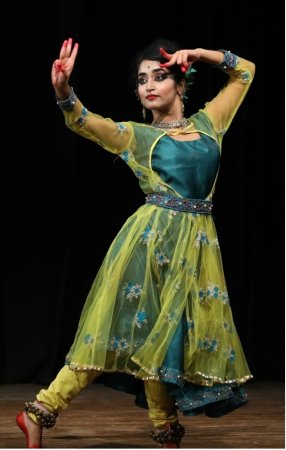 Tanmoyee Chakraborty Heralding a start to the festival on August 22 was Tanmoyee Chakraborty, a disciple of her Guru/mother Keya Chanda, a gold medalist from International Cultural Olympiad in Malaysia, Singapore and Bangkok. The crisp clarity in each etched movement and rhythm pattern, makes her a scintillating dancer to watch. She began with Shiva Vandana and from the starting point of the couplet Angikam bhuvanam yasya… to jayajaya jaya, Shiva, the iconographic representations of Shiva as 'jatajhoota', damaru wielder, adorned with the snake garland, and as Ardhanga with Parvati, were all brought out in an involved presentation. Dancers are of two types and Tanmoyee's superbly animated dance, at this stage of this young dancer, comprises more of an extroverted passion than inward looking solitude. The energy and quicksilver movements of the 14 matra Dhamar Taal, impressed with absolute finish in each micro movement of torso, neck glances and in the chakkars, landing perfectly on the sama in a jump in the chakradhar paran, with the dancer, after the Parmelu in the Bedam Farmaishi, losing a jhumka which went flying (later retrieved). The abhinaya number "Bhasi barase mein to kheloongi Hori" after depicting the merriment of Hori went on to the very different mood of Krishna conquering the serpent in Kaliyadaman. The closing number comprising rhythmic virtuosity with feet planted on the rim of a brass plate (much like Kuchipudi Tarangam), which a few dancers of the Benares gharana in Kathak perform (from whom Keya Chanda learnt this and has taught the same to her disciple), dazzled in the absolute clarity of each rhythmic syllable of the padhant by Keya Chanda, as also in the sawal jawab with the tabla by Utpal Ghosh, emerging in Tanmoyee's stomping feet. PROLONGED INTERPRETATIVE DANCE TO EACH SAHITYA LINE 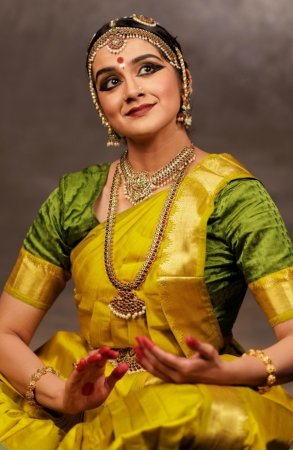 Sahana Sridhar The Bharatanatyam dancer who followed, a resident of London, Sahana Sridhar, after grooming under Renjith Babu and Vijna Vasudevan of Chennai, is currently training under Mavin Khoo. She began her recital with a Tyagaraja keertanam in Athana , "Ela nee daya radu". Addressing the 'rajeevanetra, raghuvana putra, Rama,' the devotee asks the God of Gods (devaadideva), why the Lord's compassion is not stirred, despite the devotee's ardent prayer. The centrepiece of the recital, was the well-known varnam in ragam Anandabhairavi, "Sakhiye inda velaiyil endan saamiyai azhaithodi va", built round the love smitten Nayika asking her sakhi to urgently fetch Lord Rajagopala to her side, after conveying to him, her message of love. She describes him as the unparalleled Lord, residing ensconced in the glorious Rajanagar. "Do not tarry," she pleads with the sakhi. The charanam, even as Spring, with songs of the cuckoo, heralds the ideal time for love's dalliance, expresses the customary Nayika plaint of being tormented by the arrows of Manmatha. Well trained, Sahana's technique is very clean, in the Kalakshetra mode of Renjith and Vijna and her teermanam punctuations between lines of the sahitya, were flawless in rendition. But the varnam choreographed by Mavin Khoo, who has a flair for innumerable interpretations spun into the abhinaya round each sentence, makes an item like the prolonged varnam, overlong. Sanchari interpretations need, without being self-indulgent, to be sufficiently varied and lines describing the cuckoo singing and Rajagopala atop the hill, despite the dancer's involvement, evoked a feel of being overspun. Sahana ended with a Swati Tirunal composition in raga Brindavani, portraying Radha persuading Krishna into joining her in the Kunj, with nature rejoicing in the delights of Spring, and the river water filled Jamuna flowing gloriously by. Again the choreography would seem not to be satisfied with just the words of the vaagayekar, for solfa passages; a Kavit and ripples of raga Behag were tagged on and Swati Tirunal disappeared as the heroine ended, looking crestfallen at the usual disappearing act of Krishna. Sahana acquitted herself well. The recorded tape to which she danced had Deepu Nair providing vocal support, mridangam was played by P.K. Siva Prasad, nattuvangam was by Vijay Kumar, and on the flute and veena were Krishna Prasad and Ananthanarayanan respectively. LUCKY MOHANTY REDEEMS HIMSELF 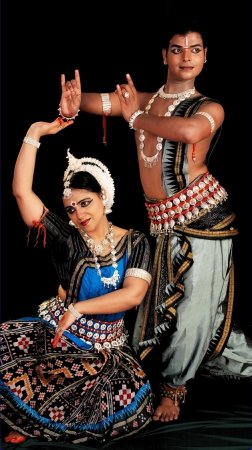 Lucky Mohanty and Bidya Das The next evening, Odissi duo comprising Lucky Mohanty and Bidya Das, disciples of Kumkum Mohanty, for this critic, was reassuring in Lucky redeeming his image of dedication to Odissi, after the very indifferent appearance one was treated to in a program three weeks earlier. Having diligently worked on his physique, the now more trim body, brought out the graceful deflections of the Odissi style with panache. The more experienced dancer in this duo with a presence, the start in Mangalacharan with the "Ahe nila saila" depicted through quick scenes had Vishnu protecting Gajendra in Gajendra moksham episode, the rescuing of Draupadi from the cruel disrobing attempt of the Kauravas and Bhakta Prahlad protected by Narasimha's destruction of Hiranyakashipu. Lucky's presentation brought out the delightful Kelucharan choreography of the Arabhi Pallavi. And the mardal playing in the recorded music was a delight. The best part of the program was the Ashtapadi "Kuru yadu nandana," where Radha in post-intimacy languor, entreats Krishna to repair her deshabille, by doing up her unkempt hair, applying fresh collyrium in her smudged eyes and tying the girdle round the waist. A male dancer like Kelucharan often presented this with an ecstasy which has not been equaled by any female dancer. Lucky Mohanty gave a highly involved presentation. One hopes he will adhere to this bodily discipline. Bidya Das presented the concluding item choreographed by Kumkum Mohanty of a composition in raga Ahir Bhairav set to taal khemta of a composition by Nityananda Mohapatra, "Saja kumjan raja kunje aare," wherein the sakhi informs Radha to come to the Kunj wherein Krishna is waiting for her on the banks of the Jamuna. Passionate conviction going beyond correctness of gestures and movement is what one would like to have. FEISTY KALIYADAMAN IN SAMIKSHA SHARMA'S KATHAK 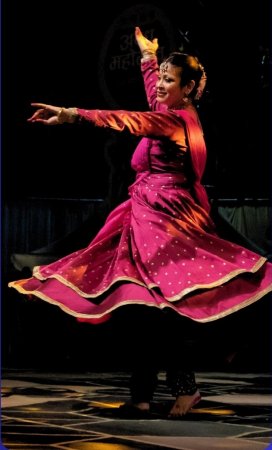 Samiksha Sharma A product of the Kathak Kendra trained in the Jaipur gharana under gurus like Rajendra Gangani, Samiksha Sharma, under ICCR's ambassadorship has served as dancer/teacher for four years in places like Tashkent, and in Uzbekistan where she also engaged in research into the dance of the Uzbekis to give her some insight into history and the Mughal influences in our Kathak. A very finished dancer, she has fashioned a Nritta Natika in a full length dance drama using the story of Kaliyadaman. She started by tracing the earlier myth of how the son of Rishi Kashyap and wife Kadri, Vedshira, because of his poisonous tongue cursing one and all, was punished to be born as a poisonous snake in Ramanaka Dwipa, from where, in fear of Garuda, Vishnu's eagle, he escaped to the waters of the river Jamuna. Here he became a threat to all men and animals, till in the process of trying to retrieve a children's ball which had fallen into the Jamuna, Krishna accosted Kaliya, and in the ensuing fight subdued the snake and danced on his hood. He finally agreed to allow the repentant snake to re-enter his old home in Ramanaka Dwipa. With all the ad-forms of Kathak strung into the dance narrative, Samiksha Sharma's was a very absorbing recital, with Nishit Gangani on the tabla, Mahavir Gangani on pakhawaj, Shoaib Hasan's vocal support, Ayub Khan on sarangi and Praveen Prasad on padhant. While one had no complaints about the main dancers chosen for the festival, a word about the compering. While correct in language and diction, the announcement of the sahitya of compositions became a travesty -sounding like some unknown language - not surprising for few would be even in nodding terms with all languages like Oriya, Sanskrit, Tamil and even Hindi. Why not just mention name of composer, larger oeuvre from which the composition is selected and its raga and meaning, leaving out the sahitya of the opening line? Similarly trying to catch in two lines the history of a classical form makes little sense - such as Odissi originated in the temples of Odisha - which is not fully correct for the temple Mahari had lost her place when the main Gurus who largely came from Ras Lila with training in Gotipua and were working for Theatre groups in Odisha, refashioned the present Odissi form, wherein the temple and Mahari influence could be an added factor. Unfortunately, dancers who often give these write-ups to the compere are not all well informed. It is a good sign that attendance for dance shows is improving in IIC. But with children running up and down and occupying front seats and talking, a sense of gravitas seems lacking in some shows. Surely, one can have youngsters and insist on some discipline. REDEEMING DRAUPADI'S NAME What with bandobast by no less than khaki-clad men, and with political and bureaucratic bigwigs in attendance, and above all a packed Stein auditorium, Draupadi Dream Trust, founded by Neera Misra twenty years ago, to focus on Research, Documentation, Promotion of ancient Civilization, Culture and Itihasa to create a better understanding at every level, in celebration of International Women's Day, presented Maharani Draupadi, Antarkatha, a dance drama in the Bharatanatyam style. The larger purpose was said to be to redeem Draupadi's honour in the face of what was mentioned as the deliberate distortions with unsavoury myths besmirching her image. Surprising, for one would have thought that Draupadi has always been held in the popular mind, as one more sinned against than sinning! Among the distortions mentioned, except for Draupadi's laughing at Duryodhana's mistaking the water pool in the new palace of the Pandavas, for a carpet (described as a widely circulated mistruth since she was not even present in the area), I feel that Draupadi's intelligence, high birth, her place as princess of Panchala kingdom and the fact that the Kaurava attempt to disrobe her failed because of Krishna as saviour, have never been questioned - no matter what changes one introduced in the Mahabharata narrative. 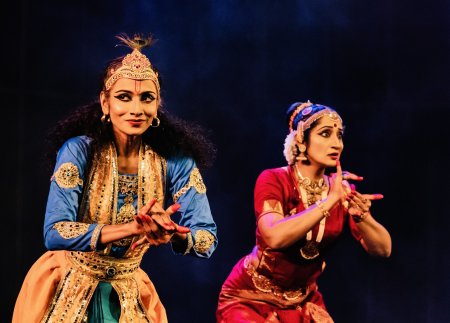 Bhadra Sinha and Gayathri Sharma (Photo: Vinay Tiwari) Already presented in the Kathak style, this version in Bharatanatyam was presented by the duo Bhadra Sinha and Gayathri Sharma, trained under Guru V. Krishnamoorthi and Guru Yamini Krishnamurthy respectively including other teachers (Bhadra is a journalist by profession while Gayathri is a corporate leader in Communications and CSR). Based on the original script and concept by Neera Misra, the writer-poet Akbar Mahfooz Alam Rizvi penned a sensitive Hindi adaptation, first presented in the Kathak style in dance. Seventy five percent of the original retained with some other additions, provides the base script for the Bharatanatyam version with Sudha Raghuraman's evocative music (composed and sung by her). According to Neera Misra, Mahabharata is wrongly interpreted as a war manual. Krishna asks, "Meri pyari sakhi, dukhi kyun ho" (Why are you sad, my dear friend?). Draupadi requests that he inform the ignoramus about the truth regarding her (Moodhon ko updesha karo). Krishna asks her to ignore the mistruths doing the round. "You are the Maryada of Hastinapur," he says. When untruth becomes the truth, he says, 'Let them tattle'. "I am blamed for causing the Dharma Yuddha, when all I pleaded for was Nyaya (justice). Despite all the greats present in the durbar, and my pleading with them for justice, I got no reprieve, except from you." She finally says that it is because of her call to Krishna, that he came out with the indelible message of the Gita. Krishna finally comes out with the statement of crowning glory for his sakhi Draupadi when he says, "You are the Beeja Pran of the Gitopadesh!" Rendered as an interaction between Draupadi and Krishna, with snatches of action representing a throwback to what had transpired in the Kaurava court, both Bhadra Sinha as Krishna and Gayatri Sharma as Draupadi gave convincing performances and what with the lusty applause for every scene, there was no dearth of encouragement. Performances of this nature are a painless way of spreading information about our itihasa. Enacting the Draupadi story apart, one wishes the treatment towards women on the ground, would show some impact from these presentations.  Writing on the dance scene for the last forty years, Leela Venkataraman's incisive comments on performances of all dance forms, participation in dance discussions both in India and abroad, and as a regular contributor to Hindu Friday Review, journals like Sruti and Nartanam, makes her voice respected for its balanced critiquing. She is the author of several books like Indian Classical dance: Tradition in Transition, Classical Dance in India and Indian Classical dance: The Renaissance and Beyond. Post your comments Pl provide your name and email id along with your comment. All appropriate comments posted with name and email id in the blog will also be featured in the site. |